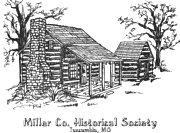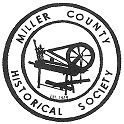|
Monday, Janury 12, 2009
Progress Notes
A couple of weeks ago I featured the story of the Arthur Pope family as told by his grandson, Morgan Pope. As noted then, the Pope family contributed much to the history and development of Old Bagnell. This week I will present a portion of the story of John Pope (photo 01), brother to Arthur, as told by his daughter, Nelta Pope Morgan.
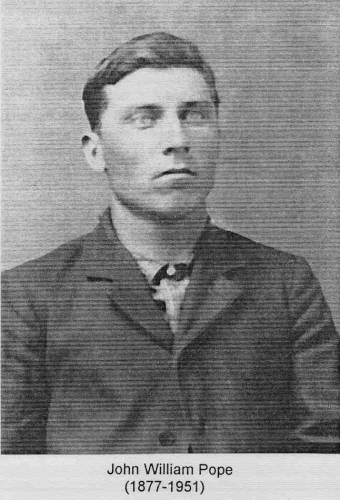
01 John William Pope
Nelta, with the additional help of her niece, Neta Pope, researched over many years the extensive history of the Pope family. This work was reproduced in a large two volume book set, a copy of which is in our museum library titled: John and Maud Pope…Their Lives and Times.
The part of this very interesting and complete Pope family history I want to explore this week is about the John Pope family’s time in Old Bagnell. Some of this information was presented in the narrative about Arthur and Walter Pope presented earlier a couple of weeks ago as noted above. Nelta has a wonderfully interesting style of writing and brings to life many of the activities occurring in the lives of her parents and siblings while they lived in Old Bagnell. Especially of interest is Nelta’s description of Old Bagnell during its early development before the beginning of the construction of Bagnell Dam. Those readers old enough to remember Bagnell that far back will recognize many of the names of people Nelta mentions in her narrative. I believe this history of Old Bagnell is the most complete I have come across so I wanted to get it recorded on our web site. For those who want to read the entire Pope history, the book gives these two addresses for obtaining copies:
Philip and Janne Morgan
6701 N. Charleston Drive
Kansas City, Mo. 64119
816 452 3323
Janice and Bill Ainsworth
6504 N.W. 67th Terrace
Kansas City, Mo. 64151
816 587 2388
As was related in the previous discussion of the Pope family, the original farm owned by John’s father, Greenberry Pope (photo 02), was located west of Brumley on the Wet Auglaize Creek.
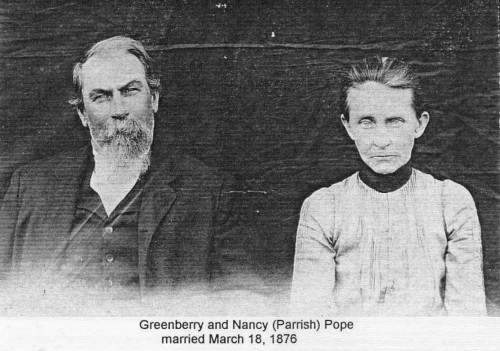
02 Greenberry and Nancy Parrish Pope
The family lived in a large house built by Greenberry (photo 03) John worked hard to help his father, Greenberry on the farm and his father helped him later on when John farmed near Hugo, Mo. (photo 04).
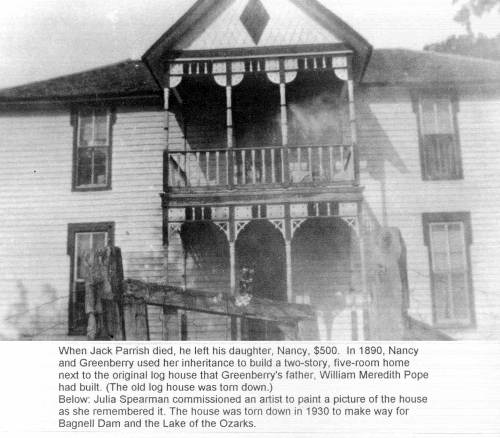
03 Greenberry and Nancy Pope Home
Click image for larger view
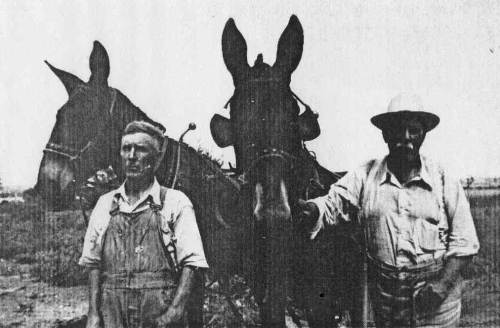
04 John and Greenberry Sr. Pope with team of Mules
After John married Maud they eventually moved to a farm near Passover, just over the line in Camden County. Following that they decided to move to Old Bagnell. This is where I decided to begin to copy from the family history as written by Nelta. In the following narrative you will read Nelta’s description of how to drive a Model T Ford, how to card and spin wool, a complete recounting of the tragic Crisman/Thompson feud, the contents of an old time general store, invasion of Bagnell by the Gypsies, and a train derailment as well as much more. For reference as you read the narrative I am placing here a map of Old Bagnell (photo 05) and a location guide (photo 06).
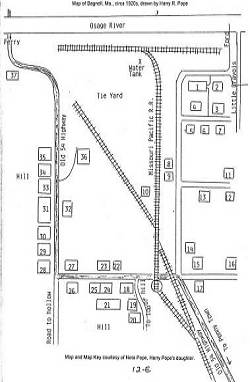
05 Bagnell Map
|
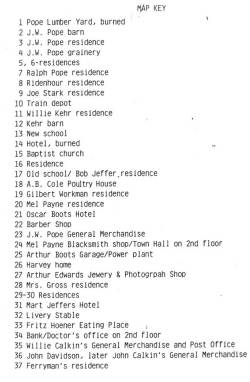
06 Bagnell Map Key
|
Click images above for a larger view |
Also, for those who are interested in placing the names of Pope family members who are mentioned in the narrative, click HERE to view the Pope genealogy put together by our museum director, Nancy Thompson.
A New Business and a New House
The Story of John and Maud Pope in Old Bagnell
Nelta Pope Morgan assisted by her niece, Neta Pope
In spite of floods and dry spells, the crops had been good. John and Maud’s prosperity had continued here on the farm near Passover. They had been able to accumulate some savings. John wanted to join his brother, Arthur, in a business venture. Husband and wife had spent much time praying and discussing the possibility of leaving this farm near Passover, weighing the pros and cons back and forth. John thought it would be less hard work for Maud but it would be quite an adjustment living in town. At last the decision was made…John would go into the lumber business. It was late in the winter of 1913 when he set out to find a suitable location for a lumberyard.
The town of Bagnell in Miller County had been established in 1881. It was here that the Lebanon branch of the Missouri Pacific Railroad terminated on the Osage River. It was always said that Linn Creek transacted more business than any other town of its size in central Missouri, but Bagnell was fast approaching the time when it might lay claim to this honor. There was no telling what the future held in store for this fast growing town. John liked what he saw. What better location could there be for a business than here among the picturesque bluffs and alongside the Osage River. He purchased about forty acres of land to build the business and a home for his family.
The children were elated at the prospects of moving into town; it would be a new experience for the whole family. As Maud and the children would remain on the farm until the business and home were completed in Bagnell, John made arrangements with a neighbor, Elijah Degraffenreid, to farm his land the coming season with the help of eleven year old Ralph, John’s son.
By the middle of January 1914, plans for a lumber storage shed began to take shape. Riley Degraffenreid helped in its construction, which was started as soon as the weather was warm enough to pour concrete. The first load of lumber was received in early March, and a carload of cement arrived the first of April, followed by a couple more carloads of lumber. John was in business (photo 08).
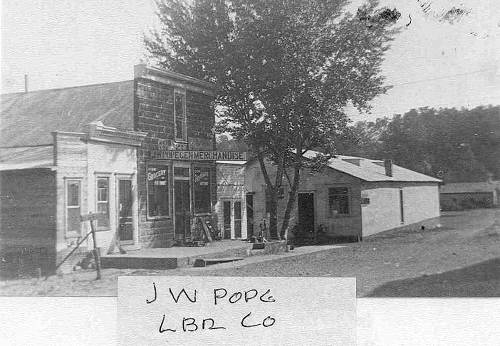
08 J. W. Pope Lumber Company
The family’s new home was completed in 1914 (photo 08a).
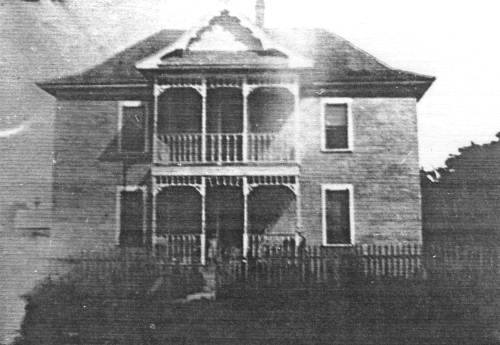
08a Pope Home in Bagnell - Built in 1914 for 500 Dollars
A bank had now opened in the Harvey Store building with a capital stock of ten thousand dollars. This modern bank had a fire proof vault and a Burroughs adding machine. Standard Oil Company erected an oil supply tank to accommodate Bagnell. It was hoped that a Baptist church would be started in the spring of 1914. Harvey’s had a produce company and was dealing in the tire industry. There were three stores: one was Kehr Brothers, another was owned by Mr. Davidson, and the third was operated by Joseph Gier; all had well stocked general merchandise businesses. The telephone switchboard, located in the Boots Hotel (photo 09), was managed by Mrs. Boots and her daughters.
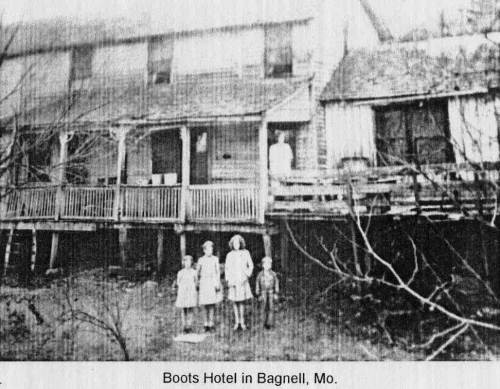
09 Boots Hotel
Freight to and from Bagnell was taken care of by the Missouri Pacific railroad agent and telegraph operator. There were a couple of restaurants in town: hot lunches were served at the Howser establishment, and Honer’s served light lunches. Fritz Honer also carried a line of groceries, such as crackers, lunch meats, cheeses and salmon. After the Pope family was settled in their Bagnell residence, the children were often sent to Honer’s place to pick up some of these goodies for Sunday evening snacks. Mr. Honer later sold ice cream cones.
No town could make do without a blacksmith and Bagnell’s was a mechanic of great ability. Melvin “Mel” Payne’s chief skill was that of an iron worker (photo 10).
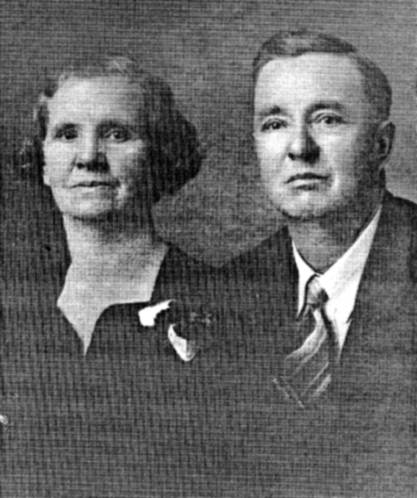
10 Melvin and Frances Payne
Mel retired the farm wagons; re wheeled the buggies, repaired metal parts of machinery and did odd jobs of welding iron works. The fire in the forge was kept alive and hot by the bellows. Sparks flew from glowing metal under the hammer, the ring of the iron anvil echoed and steam hissed from the tub of water used to cool hot horseshoes. The pungent odor of a singed hoof in contact with a hot shoe filled the air. The breeze carried the sharp smell of the sweaty horsed, which were stomping their feet and swishing their tails at flies in the shade of a nearby tree as they awaited their turn to be shod. The shop was strewn with old, iron buggy and wagon wheel rims, worn out horseshoes and various odds and ends. Empty nail kegs supplied seats for town bums. It was truly a masculine place, a very satisfying spot for men to gather and pass the time of day. Payne’s Blacksmith Shop was a real asset to the town.
The lumber company was thriving as there was much building being done in Bagnell and the surrounding country. Another lumber shed was started, but a strong windstorm blew the roof from the structure before it was finished. John was not to be discouraged; the rebuilding of the shed started immediately, using salvaged materials and a small amount of insurance money.
The lumber business flourished under John’s management, plus he had won the confidence of the people by his honest and fair dealings and by his generosity to his friends and community. He eventually added a line of undertaking goods to his lumberyard stock.
Bagnell was a growing town, large enough to support its stores and other businesses. The two hotels were patronized by weary travelers, many of them businessmen coming in on one of the two daily passenger trains. Now that the Model T Ford was in full production, more people were traveling and found Bagnell a good place to spend the night.
The year of 1915 was very unusual weather wise. There were heavy snowfalls during the winter months followed by heavy rainfalls, causing the Osage River to flood. Backwater came up, covering the entire town of Bagnell. The water receded, leaving a thin coating of ice on which the children enjoyed slipping and sliding. May of that year had a total rainfall of eleven inches, causing more flooding. The Pope home, built on higher ground, was surrounded by the muddy, swirling waters. Boats were the mode of transportation during the time of high water. Sometimes John and the boys had to walk the railroad tracks to get to town when the water covered the road alongside the elevated tracks. Another record was set in August of 1915. It was the coolest month on record, with a high of only ninety degrees. On August 30th, the thermometer dropped to forty seven degrees, the coldest day recorded for that date.
Homer Vance was cashier of the Bank of Bagnell and through his untiring and fruitful efforts, became a great friend of his business associates. Later, he and John became partners in farm equipment.
The Bagnell merchants had extremely good business. Some Saturdays as many as three dozen or more wagons were in the square. The people from the country came to town to purchase their needs at the local businesses and brought with them their produce to sell at the stores.
New businesses were added to the growing town all the time, including a large poultry house. Mr. A.B. Cole purchased lumber from the Pope Lumber Company and John was in charge of the building construction. The Cole Produce House was soon being patronized. Poultry and eggs were brought in by farmers of the surrounding countryside and sold to the poultry house. The eggs all had to be candled. By holding an egg over the candlelight, it could be determined if the egg was good. The spoiled ones were rejected and destroyed. Harry, who was gifted in tinkering and whittling wood, was paid a dime to make a dozen egg cases for Mr. Cole. This was big money and just for doing a fun project!
Arthur Edwards (photo 11) opened a jewelry store, selling fine jewelry as well as repairing jewelry and clocks.
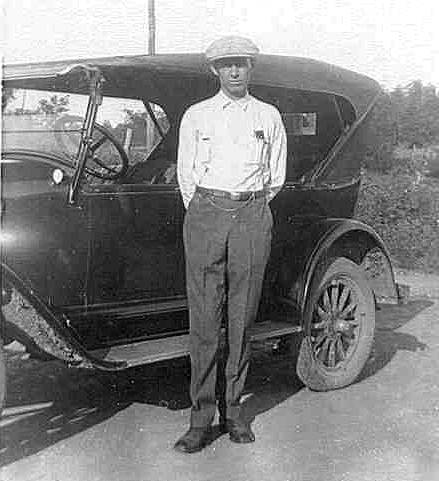
11 Arthur Edwards
He also did some photography, resulting in very pleased patrons. Alice Edwards, his wife, was proprietress of the Ladies Millinery. Many beautiful hats were displayed and sold there. A selection of velvet, satin, taffeta and felt hats adorned with sequins, bows and feathers was available for winter. Straw hats, bedecked with colorful flowers, leaves and ribbons were for sale during the summer months.
The lowlands and waterways in Bagnell were infested with copperhead snakes. Maud was cautious when picking beans or other vegetables. She was always on guard for fear that a snake would be coiled up under the leaves in the shade of the plants. She took the hoe to the garden with her, just in case she should encounter one. A large rattlesnake was killed near Bagnell. It had fifteen rattles and a button. The snake was hung from a tree limb for people to see.
John was elected president of the Bagnell School Board in 1916. It was typical of John, a strong believer in the importance of a good education, to willingly serve on the school board. Even more reason for John’s involvement in the education process was his six children who were now attending Bagnell School (photo 12).
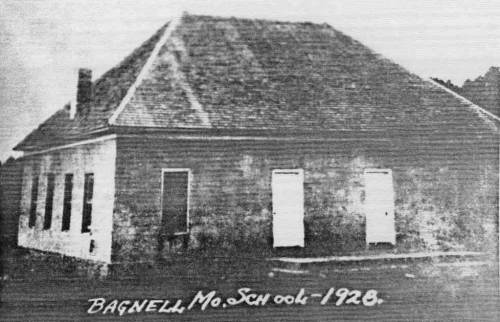
12 Bagnell School - 1928
Both the school, which had been relocated from near Pennytown to Bagnell, and the Bagnell Baptist Church (photo 13), approved by the Southern Baptist Church Association, were constructed on land donated by John and Maude.
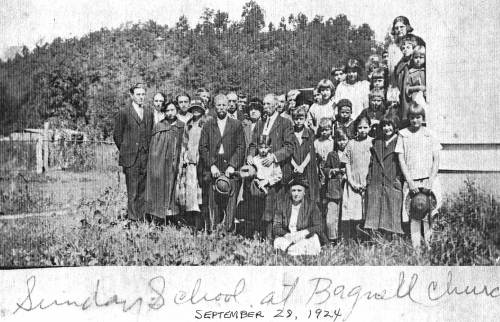
13 Oliver Brockman on Left - Sunday School at Bagnell Church - 1924
Click image for larger view
They also furnished much of the materials and labor for these concrete structures. Although Sunday school was held regularly each Sunday, the church did not have a regular minister; one normally came once a month to hold church services. Twice a year, usually in the early winter and in the spring, a revival, or protracted meeting, was held. The revival lasted two to three weeks, depending on the interest and inspiration sparked by the minister’s sermons. The meeting was usually brought to a close with a baptismal service held at Little Gravois Creek (photo 14).
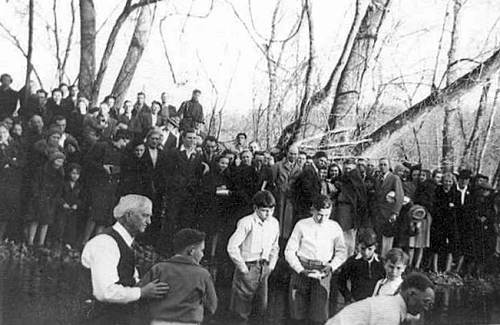
14 Bagnell Church Baptism
The women and girls, wearing their regular clothing, pinned their dresses between their legs to keep their skirts from floating up when they waded out into the creek. The water was often icy cold with the temperature hovering near freezing, causing bodies to shiver and teeth to chatter. Being immersed in the frigid water was a shock to mind and body. A blanket was a welcome protection from the cold air as the new converts hurried to a warm shelter and dry clothing. A bountiful potluck dinner was served at the close of the revival. John and Maud had been baptized earlier in the Auglaize Creek in 1911 (photo 15).
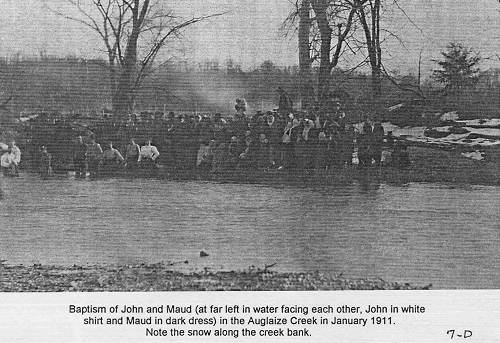
15 Baptism - John and Maud Pope - 1911
Click image for larger view
Maud read music quite well. She played the organ and John accompanied her on the accordion. John played music mostly by ear. However, some of the hymnals had shaped notes that he learned to read. Each note had a different shape which indicated a tone of definite pitch (photos 15a and 16).
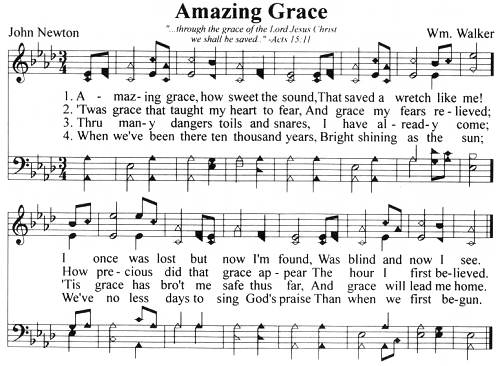
15a Example of Shaped Notes in a Hymnal

16 The Shaped Note System
A literary society was organized and met at the schoolhouse. John was elected vice president and Clara was elected secretary.
John, a believer in progress, added the Springfield wagon to his inventory of tractors, plows and other farm machinery. Besides lumberyard materials, he carried a full line of many sundry items and stocked a nice line of caskets and other undertaking items in his inventory. As he became involved in more and more enterprises, the business grew and thrived.
Buying hogs on foot from the farmers, John could guess their accurate weight within a few pounds. The purchased hogs were driven on foot to Bagnell where John had a feed lot. Here, the hogs were fed until they were fattened; then they were shipped by rail to the stockyards in East St. Louis.
The Pope children looked forward to visiting their Selby grandparents in Linn Creek. Sometimes the girls took the steamboat to Linn Creek, where they were met by Maud’s parents and then continued by buggy to their grandparents’ farm near Hugo (the name was changed from Chauncey to Hugo in 1915).
Maud always had a desire to take a boat trip on the Osage River. When the opportunity came, she was fast to accept the invitation from her friends, Sam and Nellda Salsman. The tow boat, The Nellda, which pushed a barge, was home to the Salsmans’ (photo 17).
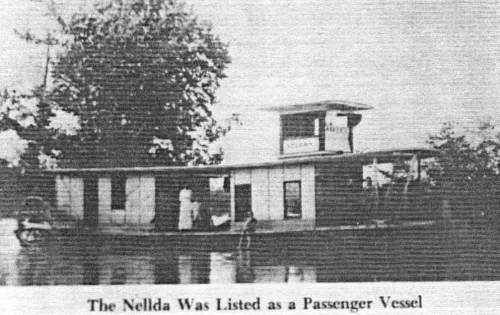
17 The Nellda
So in September 1917, Maud, accompanied by her children, started the one hundred twenty mile round trip excursion from Bagnell to Linn Creek and back home. The tow boat was powered by a kerosene engine driving a large paddlewheel. Many boats and barges docked at Bagnell to deliver various types of goods for the stores (photos 17a and 17b).
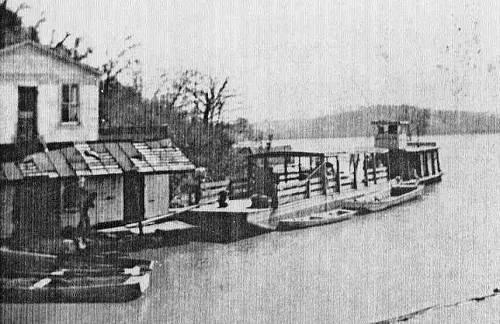
17a Boat and Barge
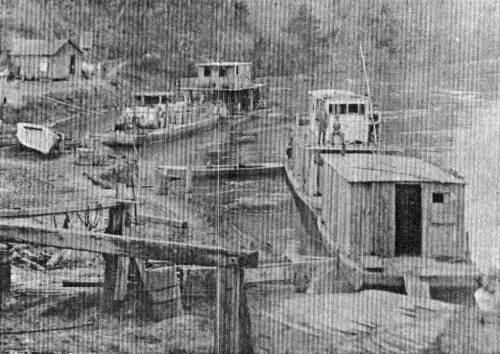
17b Boats and Barges
A special treat was in store for the Pope children when they were allowed to attend the Big Show at the Star Theater in Bagnell. For a nickel or a dime, they could see three reels of moving pictures shown on Tuesdays and Saturdays. A sandy beach beside the clear Little Gravois Creek with its gravel bottom provided an inviting place for the young people to congregate. There wasn’t much skin exposed when the girls arrived in their romper like bathing suits. Rows of lace trimmed ruffles embellished the neck and sleeves as well as the mid thigh length overskirt. Full Bloomer legs came below their knees. The boys’ suits were sleeveless and knee length. Many times they went to the ice cream parlor where their friend, Alta Jeffries, was the proprietress.
Bagnell was the end of the line for the Lebanon branch Railroad. The railroad tracks ran alongside the Osage River. A turntable (a circular, horizontal rotating platform equipped with a railway track) was used for turning locomotives around (photo 18).
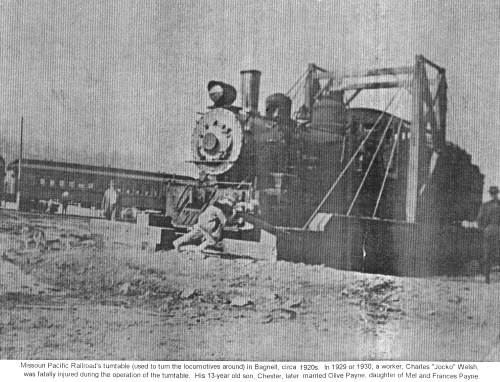
18 Missouri Pacific Railroad Turntable
Click image for larger view
A railroad water tower located near the river supplied water for the steam engines. Railroad engineers, the road gang, who maintained the tracks, and other personnel of the railroad patronized the local hotels and restaurants.
Bagnell was the largest railroad tie town in the world. The ties were loaded at Linn Creek and other places along the Osage River and floated downstream to Bagnell. It was estimated that between 250,000 and 300,000 railroad ties were delivered by raft pilots to this town each year. Here they were loaded onto railroad flatcars and shipped to all parts of the United States. The railroad tie industry brought many people to Bagnell seeking work (photo 19).
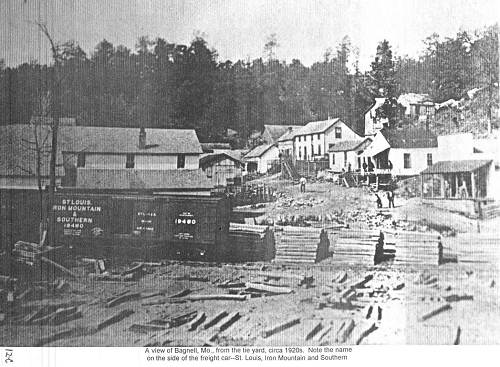
19 Bagnell Tie Yard
Click image for larger view
The tie yard was a busy place during the river’s navigable season. Men worked daily loading the ties onto the railroad flatcars. These men toiled hard, their bodies stooped from lifting the heavy ties and their legs knotted with broken blood vessels. It was hard work but an honest way for them to make a living for their families.
John bought many carloads of corn and sold it at a small profit to the area farmers whenever there was a scarcity of corn in Miller County. John became associated with Mr. Hawn, a miller in Olean, and they bought wheat and corn in Bagnell and the surrounding vicinity to ship through out the country.
The Pope boys enjoyed living in town. They were fascinated with the activities at the lumberyard and they enjoyed hanging around the depot at train time. It was of interest to the boys to be there in the mornings to watch the arrival of the passenger train at the train depot (photo 20), as many of those arriving were traveling salesmen.
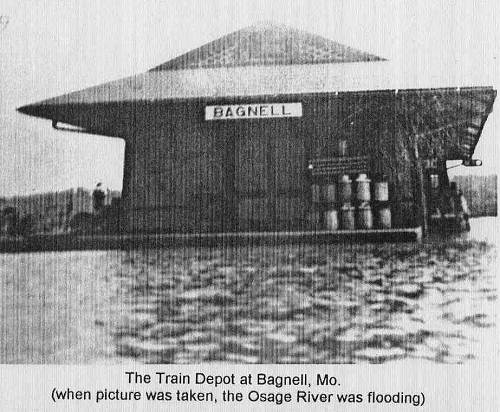
20 Train Depot
The salesmen would rent a vehicle and horse from the Bagnell Livery Stable. Mr. Thornsberry, the owner, carried a nice assortment of rigs to accommodate his patrons: buggies, hacks, carriages, surreys and wagons. The salesmen visited small business merchants throughout the surrounding countryside, displaying samples and taking orders from their sales catalogues. They also visited the Bagnell merchants, helping them to select and update their current stock. Weary travelers who spent the night in town boarded their horses at the livery stable, assured that they would be well cared for. The hotels were all patronized by train passengers and travelers passing through town. The newly opened twelve room Vann Hotel was a much needed and welcomed addition to the town. The other two hotels had been unable to provide lodging for all the transients and patrons wanting to spend the night in Bagnell.
The freight train arrived every afternoon. The men, assisted by teen age boys, unloaded the merchandise from the rail cars onto waiting wagons and riverboats and delivered the goods to local and surrounding small town merchants. Harry often watched the men, stooped from the weight of heavy sacks of cement and kegs of nails, loading riverboats and barges from the rail cars. Two men laid a sack of cement onto each shoulder and one across the back of the carrier’s neck. The carrier then walked down to the river bank, across the gang plank and onto the river boat or barge, where two men relieved him of his heavy burden. This laborious task was repeated until the boats were loaded. The cargo was then transported up the Osage River to Linn Creek, where the supplies were reloaded onto wagons and taken to the A.M. Pope Lumber yard, John’s brother’s business. The boats and barges, on their return trip to Bagnell, brought wheat, corn, livestock and produce to be shipped by rail to large cities.
As many as two boxcar loads of cement, roofing, paint, kegs of nails, lumber and other merchandise came in daily via the freight train to replenish the lumberyard stock. John also purchased salt by the carload. The heavy supplies were loaded onto waiting wagons by hired men and boys and taken to the lumber shed and storage buildings. Tom Quinn, who operated a drayage business, transported much of the supplies for the lumber yard. (A drayage is a large, flat bed wagon without sides.) The wagons were pulled by a team of draft horses.
Large barrels of coal tar, used for patching rooftops, were stocked at the lumberyard. One of the boys, and yes, Ruth’s, favorite pastimes was chewing this black, gum like substance.
A ferry was pulled across the Osage River by a wire cable attached to a pulley (photo 21).
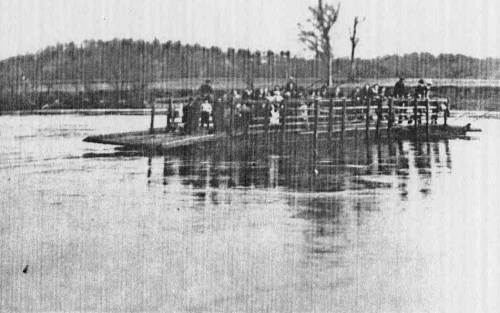
21 Bagnell Ferry Loaded
As a wheel turned the pulley, it created a pulling force to move the ferryboat. A school type bell, situated on the bank across the river from Bagnell, was used to summon the ferryboat operator for night ferry customers. An increasing number of the Model T Fords crossed the river on the ferry. The Bagnell Ferry rates were: footman, round trip, 5 cents; horse and rider, 10 cents; horse and buggy, 15 cents; round trip 20 cents; two horse buggy or wagon, 25 cents; round trip 35 cents; Ford cars, one way or round trip 50 cents; large cars, one way or round trip, 75 cents; one ton truck, 50 cents; and two ton truck, 75 cents.
World War I Era
The War of the Nations, or World War I, was an international conflict that involved the principal nations of the world. It broke out July 28, 1914, involved twenty nations and was unmatched in history for its titanic character. The Allies, which included Great Britain, France, Russia, Italy, Japan, the United States and other smaller countries, were pitted against the Central Powers of Europe, which included Germany, Austria, Hungary and others. The principal fighting occurred in France and Belgium, along the German border.
Many American soldiers returning from the war suffered from weak lungs and labored breathing as a result of being “gassed.” John’s brother in law, Leonard Williams, and Clara’s brother in law, George Engleman, both suffered from the effects of the gas poisoning for the rest of their lives. The first Miller County war casualty was Charles McDaniel (photo 22).
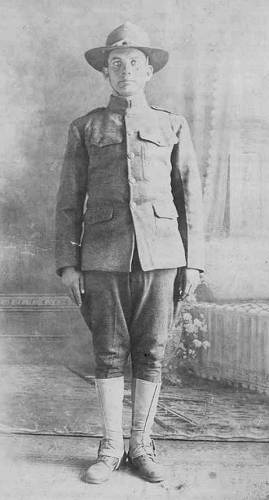
22 Charles McDaniel
He was killed in action in France in late December of 1917; his body, however, was not returned to his homeland until early March of 1922 for reburial.
(Note: Charles McDaniel was an uncle of my mother in law, Elva Steen, whose mother, Maggie, was a sister to Charles.)
During the war, Tuesdays were designated as meatless and Wednesdays as wheatless, as part of the food conservation program. John and Maud were active in events pertaining to raising money for the Red Cross. John was a member of the Executive Committee of the Home Service Campaign for Humanity’s Sake of the Salvation Army. He also joined the Maccabees Home Relief Association and was given the title, “Sir Knight John Pope.” The Maccabees met in a hall, which Mel Payne had recently opened, above the blacksmith shop.
The hall was used for traveling shows, medicine shows and, occasionally, a place to show rented movies. This was a family oriented recreation center and was enjoyed by all who attended.
Mel Payne, well liked and energetic, was responsible for bringing much of the entertainment to Bagnell. He was a jovial, kind, considerate and highly respected man. He was a talented musician and played many stringed instruments, often playing for dances. He was song leader at the Bagnell Baptist Church, where his family worshipped and participated in the church school activities.
The war finally ended on November 11, 1918. That day as was true on many other days, parents, relatives and friends of the young men who had received orders to report for service in the war had accompanied them to Bagnell to see them off at the depot. Bagnell was overflowing with people. Two passenger rail cars were loaded with boys from Camden and Miller counties, their loved ones waving their final farewells, when the depot telegraph operator received information to hold the train. The great awaited word had arrived: ARMISTICE! The Armistice had been signed, signaling the end of World War I. Eleven was the number on everyone’s lips, for the Armistice had come in the eleventh month, on the eleventh day and at the eleventh hour. The train cars emptied quickly with much jubilation, joy, crying, laughing, whooping and hollering. The whole town went wild in celebration. Someone ran to the school, announcing the great news. School was immediately dismissed and the students joined the crowd.
Many of the boys who had been ready to leave on the train were acquaintances of the girls who came to the depot to join in the celebration. Everyone was hugging and slapping each other on the back.
Bedlam was prevalent. John held Ruth in his arms to keep her from being trampled by the crowd. John, who always took great pride in his hat, was aghast when someone grabbed it from his head, threw it up in the air and blasted it with a shotgun. Pieces of hat flew everywhere! Someone in the crowd picked up a piece of the hat and laid it on John’s head. He accepted the incident in good humor. The celebration continued throughout the day. Bells were rung, bugles were blown and the engineer blew the train’s whistle for several minutes. Shouting and loud talking prevailed throughout the town. The Allies had won; the cause was not lost; the young men had not died in vain. A Victory Formation of 18,000 soldiers was photographed at Camp Dodge, Iowa (photo 23).
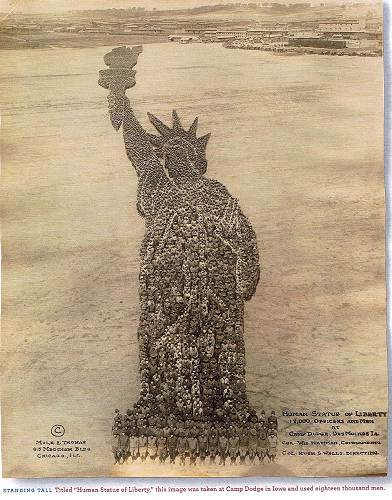
23 Camp Dodge, Iowa - 1918 - 18,000 Men
Click image for larger view
The memory of this eventful day was not laid to rest in the Pope family but was remembered and discussed often throughout their lives.
The Model T Ford
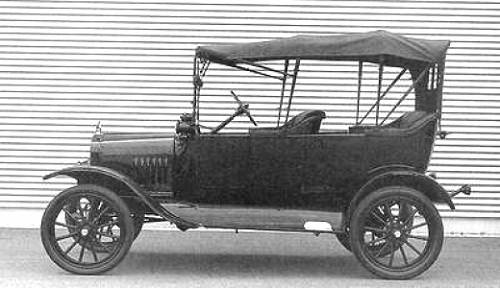
24 Ford Model T Touring Car
Greenberry, John’s father, purchased a Ford motor car in the spring of 1917 but never had the desire to drive it. In late July, John purchased the Model T from his father for three hundred dollars. It was black, the only available color when the cars first came on the market. Even though Greenberry didn’t learn to drive, he gave John instructions on how to operate the machine. He told him, “Son, be sure to turn quick enough to make the turn.”
Operating an early automobile was no easy job. Just starting it was a special art. The first cars didn’t have starters…a hand crank was used to turn the motor over to start the car. The crank, a metal handle projecting from the front end of the machine, was used in place of a key to start the car. Many bones were broken when the crank kicked, hitting an arm or wrist. Before the engine was started, the car was given a crank or two. The ignition switch was turned on and the car was cranked again. Usually, the motor snorted a couple of times, then quivered and sputtered as it caught and finally slipped into a steady purr.
Henry Ford was the first car maker to move the driver’s seat to the left side in his Model T. Before that, drivers sat on the right, as did drivers of horse drawn vehicles. In the early days of motoring, a driver’s license was not necessary; courage and conviction were the only requirements for driving. As there were no license plates, a wooden shingle with the owner’s name or a personalized slogan was used to identify the vehicle. A ride in a car was an adventure, as the only roads available were the rocky, dirt roads used by wagons. During dry weather, the roads were dusty; in wet weather they were a sea of mud, the equivalent of an obstacle course.
A tool box mounted on the running board contained a tow rope, a tire pump; a tire patch kit and a container to fetch water in case the radiator should boil dry. The tires, thick rubber casings with inflated inner tubes, were mounted on large, wooden spoked wheels. Rocks, ruts and lost horseshoe nails caused many flats.
Farmers liked the mule like Model T Ford as it was easy to repair. Many times it could be fixed by a novice with barbed wire from a fence along the road. If the brakes didn’t work, the reverse gear was used to stop the car. Spare parts could be bought from mail order houses. By jacking up the rear end of the car and using a pulley on one wheel, farmers could run a saw, a cider press or a hay baler. Drivers were willing to put up with such faults as poor brakes, awkward starting and its nature to creep forward in neutral.
America soon developed a love affair with the automobile. By the middle of July 1918, Bagnell boasted eight cars, and the Kehr Brothers had installed a gas pump at their place of business. One of the Boots family had a garage (photo 24a).
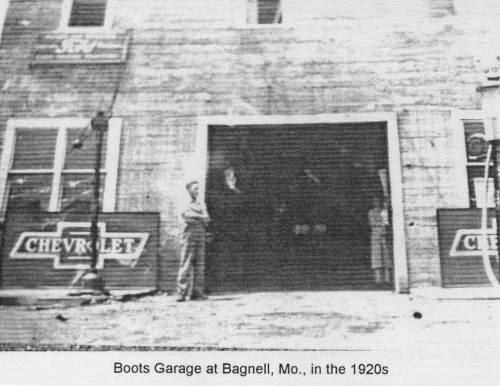
24a Boots Garage
In 1918 the price of a new car was $720. A quarter carat diamond solitaire was $25, a shotgun was $10, a gold crown was $5 and the cost of a stove was $34. Curtains were $1.69 a pair, an oak dresser was $13.95 and a mattress cost $12.75. A loaf of bread was 15 cents, potatoes were $1.25 a bushel, and meat, such as ribs, roasts, steaks and smoked ham, was 20 to 30 cents per pound. A lady’s front lacing corset was $3, a lady’s smart hat was $3.75 on sale and men’s suits were $14.95.
The telephone switchboard for Bagnell was located in the Boots Hotel and was operated by Mrs. Boots and her daughters. Telephone service was becoming more and more reliable, much improved over previous years. The telephone was a time saving luxury for the Bagnell businessmen and merchants. John was able to keep in touch with the manager of the harness shop in California, his grain business partner, Mr. Hawn, at Olean, and his brother, Arthur, in Linn Creek. Each household had its own “ring”, consisting of a combination of long and short number of rings of the telephone bell. The central switchboard could send out a certain number of rings as a signal for everyone to answer in case of an emergency or for a special announcement of interest to the community.
A most delightfully special treat was in store for the whole town when a refrigerated rail car dumped its ice after unloading perishable foods. When the train departed, people filled boxes and burlap sacks with ice to make ice cream or custard.
John purchased wagonloads of corn from farmers living near the fertile Osage River bottom land and surrounding area at a fair price. He made a small margin of profit from a shipment of seventeen hundred bushels of corn that he shipped by rail to Texas. The husked ears of corn were brought by wagon directly from the fields to John’s granary in Bagnell. John hired Henry Sanders to work for him. Mr. Sanders worked day after day shucking corn. Mr. Sanders, who came to the United States in about 1880, was a retired, successful farmer in Miller County. He was, also, a German sympathizer, contributing money to Germany as long as it was allowed. After the war, he became very despondent and committed suicide by drowning himself in the Osage River. This was a shock to the community and to his niece, Mrs. William Kehr.
Many huge fish were pulled from the Osage River (photo 25).
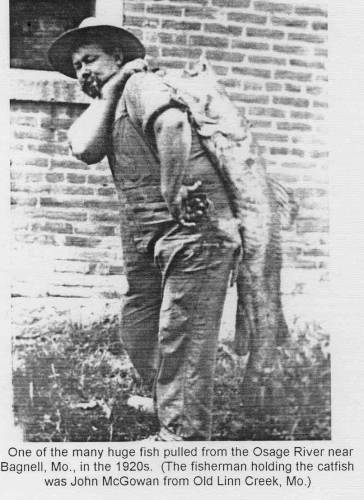
25 John McGowan with Fish
Click image for larger view
One was so big that the fisherman could not drag it into his boat. He towed it behind his boat to Bagnell where he got help landing the fish. Estimated at a weight of one hundred thirty five pounds, the fish was taken by wagon to the depot where it was loaded onto the train. Wet tow sacks were wrapped around the fish and cool water poured over it to keep it alive. It was transported to Jefferson City where it was sold.
Fish graced the dinner table quite often in the Pope home. John kept a trotline out in the river during the spring and fall months. A fish basket was kept in the “Big Eddy” up the river from an island in the Osage River. John often bought wooden kegs of whiting fish, salted down in brine. The family savored these fish dinners.
Sometimes John purchased fish from the local fisherman, Hilmer Edstrom, who made his living catching and selling fish. Mr. Edstrom shipped fish to Jefferson City by train where they were sold to the local businesses.
During the summer months Maud sat at the spinning wheel on the porch. She was taught by her grandmother, Huldah (Wilbur) Selby how to wash, comb and disentangle the fibers of wool using special wire brushed. This process was called Carding. The next step was to do the actual spinning, which involved making thread by twisting the animal fibers into yarn. As she turned the large wheel, it turned a small, single spindle driven by the rotation of the big wheel, creating loud, whirring sounds that could be heard for a long distance. At the sound of the buzzing spindle, her Bagnell neighbors gathered to watch her work. As she turned the wheel with her left hand, the fibrous rolls of wool were drawn out and fed onto the spindle with her right hand. The degree of fineness of the spun yarn depended upon the rapidity with which the yarn was drawn out. The many yards of spun yarn were wound into hanks and were ready to be dyed. After being dyed and dried, the yarn was rolled into balls and was then ready to be used to knit articles of clothing for the family.
Crisman Thompson Feud
The families of Fred Crisman and Grant Thompson, both living across the river from Bagnell, had been having difficulties for two or three years, during which time feuding and shooting occurred. No one really knew for sure what started the feuds. The problem between the families may have been the result of both Francis Crisman and Charles Thompson being teacher candidates for the same school. Francis Crisman secured the job over his opponent, arousing a spirit of ill will between the two prominent families. The involvement of the Crismans in the Ku Klux Klan also may have contributed to the Thompson family’s grievances.
The senior members of the two families engaged in a very serious fist fight while in town. After Mel Payne and John broke up the violent confrontation, John talked to both men about the senseless feud going on and about the potential for a real tragedy. Grant Thompson said that he would sell his farm and move, as he did not want any members of his family hurt. Mr. Crisman indicated that the move would be satisfactory to him.
However, in order for the Thompsons to go anywhere, they had to pass by the Crisman place; and the Thompsons were fired upon numerous times by a Crisman who hid behind a rock or log. Violence came to town one morning when Fred Crisman was accosted by Grant Thompson in front of the Bagnell Post Office. Grant Thompson pulled out a .38 Army Special revolver and fired three shots. Fred Crisman suffered a minor wound to the shoulder. For this atrocity, Grant Thompson was placed on a twenty five thousand dollar bond.
On Christmas Eve day, the Thompsons were carrying guns as they passed the Crisman place. An exchange of shots was fired, and twenty year old Francis Crisman was shot in the back, the bullet lodging in his spleen. The infuriated Crismans jumped into their car and pursued the Thompsons over to the ferry, where they shot Grant Thompson and then kicked him about twenty five feet out onto the ice of the frozen river. Thompson was wearing the horsehide coat that he had made from the hide of one of his horses which had died. He lay bleeding on the ice until the middle of the afternoon, as no one dared to become involved in the hostility between the two families. School was dismissed early in the day, as the school children could not concentrate on their work with all the action going on across the river.
Joe Thompson, with his father when he was shot, was chased on foot by the enraged and well armed Crisman clan. Joe ran for his life across the fields covered with twelve inches of snow. As the Crismans were gaining on him, Joe kicked off his boots so that he could run faster. He eventually made it to the Kidwell home, limping in on frozen feet. Elmer Kidwell listened to the young man’s dilemma and decided to protect him. When the Crismans arrived, Mr. Kidwell refused to let them enter, knowing that they would kill the Thompson boy. He told them that he just couldn’t let them do this to Joe. The Crismans left the Kidwell house, very angry that they were not allowed to revenge the shooting of their brother, Francis Crisman.
John Pope sat on the coroner’s jury, and he stated that he felt Grant Thompson would have survived had he been taken off of the ice. In his opinion, the man had bled to death while awaiting the arrival of help that didn’t come.
Francis Crisman died a week later in the Jefferson City Hospital, and his body was taken to Eldon for the burial service. Although the funeral was held at the Eldon Baptist Church under the auspices of the Ku Klux Klan, the Klan took no part in the church service. An escort of seventy members of the Ku Klux Klan, in full regalia, accompanied the body to the cemetery, where the regular order of service was conducted by the officers of the Jefferson City Klan, realm of Missouri of the Invisible Empire of the Knights of the Ku Klux Klan.
Members of the Pope family were concerned about the violent deaths of two of their neighbors. Tom was especially saddened by the death of his friend, Francis, who had encouraged and helped him in his interest in the new field of communication. It all seemed so unreal. The account of what happened between the Thompsons and Crismans was repeated many times by members of the Pope family. Each time, the story was retold so vividly that one could almost sense that they were there that tragic day. Everyone in Bagnell shared the same thought: how senseless that this conflict had such a disastrous ending. The question was asked over and over…what provoked the animosity between the families? How could formerly good neighbors and citizens suddenly become murderers?
Note: you can read more about the tragic Crismon Thompson feud as recorded by the Tuscumbia Autogram at this location on our website:
http://www.millercountymuseum.org/newspapers/thompson-crismon.html
The Catastrophic Blaze
In late March 1923, the town of Bagnell was awakened around midnight by loud, crackling sounds (photo 26).
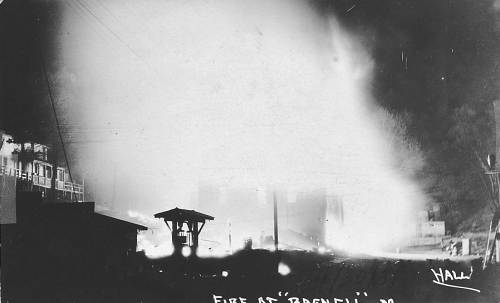
26 Bagnell Fire
As the residents looked out their windows, they saw flames leaping high in the sky. Clara was awakened by the sound of gunshots being fired to alert the town of the emergency. The flames from the fire illuminated her room. She was aghast! It was the lumberyard that was on fire. She went quickly to awaken Ralph, who ran to the lumberyard. Opening the door to the horse stalls, he released the animals. Next, he tried to remove a wagon from the shed but was driven back by the intense heat. More and more flames erupted as cans of paint and other combustible materials exploded, feeding the fire and making it impossible to enter the building to salvage anything. The lumber was a tinder box, creating a fiery inferno. The fire was uncontrollable. The flames fanned by the wind from the north, presented a ghastly, eerie sight. The whole town was bathed by the light of an orange red cloud that hovered over head. The family, surrounded by friends and neighbors, watched helplessly in awe and anguish, as the flames engulfed and reduced the lumber shed to a pile of burning embers within twenty minutes.
A carload of cement, that had been unloaded in the yard on the north side, was saved. Of eighteen wagons received in a recent shipment, only one had been assembled, and it was lost in the fire. The remaining seventeen in the north yard were not damaged.
The fire started in the cement room where barrels of coal tar were also stored. The coal tar, when ignited, may have expedited the fire, causing it to burn more rapidly and to become uncontrollable so quickly. Ralph was positive that the door to the cement room was shut at the close of business that day, but it was found standing wide open by those who first reached the burning building.
John, who had accompanied a load of livestock to St. Louis, was shocked when he returned home Saturday to find his business in ruins; beds of hot coals, ashes and cinders were all that remained of the main building of the lumberyard. This was a powerful blow to him. It was suspected to be the work of an arsonist, although there was never positive proof of this. Did someone hold a grudge against John? A likely suspect was one of the moonshiners who disappeared from Bagnell the day after the fire. His wife wrote John a letter, telling him that she was sure that her husband had committed this atrocity, as he had told her that he was going to burn the lumberyard to the ground.
The loss of merchandise was estimated to be twenty three thousand dollars, based on the March 1st inventory. The entire lot of caskets, barrels of salt, kegs of nails, boxes of screws, bolts, hinges…the list went on…was lost. A shipment of goods recently received but not yet listed on the ledger was not covered by insurance. Only ten thousand dollars was paid on the sixteen thousand dollar policy. This was a great monetary loss to John.
The loss of the lumberyard had a great impact on Bagnell and the community. It had been the largest in the county, covering an area of 10,200 square feet, or approximately a 100 by 100 square foot area.
John decided not to rebuild the lumberyard and, over a period of time, sold the wagons and materials from the sheds that were saved from the fire. He continued buying and selling grain and livestock until afforded an opportunity to find another business to his liking. John kept busy, not only with his work, but also with community activities.
Ralph, who had been managing the lumberyard in John’s absence, found employment in Kansas City. After working there a few months, he returned to Bagnell where he hauled gravel for the State Highway Department. John’s brother, Arthur, bought the undamaged buildings as well as the remaining stock and reopened the lumberyard. Arthur, who lived in Linn Creek, hired Ralph to manage the yard.
The General Store In Bagnell
After the fire John purchased one of the general stores in Bagnell from the Kehr Brothers in the late summer of 1923 (photo 27).
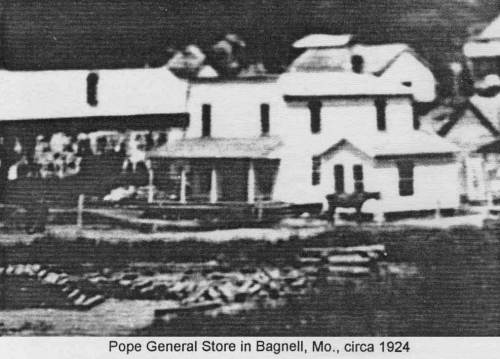
27 Pope General Store - 1924
He needed no introduction to the people, as he would be serving many of the same patrons that he had dealt with in the lumber business. His experience, generosity and fair dealings were favorable factors for a successful business venture. John was a good mixer and took great pleasure in serving the people of the Bagnell community.
One of the first things he did after purchasing the store was to build a new and higher foundation for the building. He then turned the store to face the Osage River. A covered, concrete porch was poured across the entire front of the building. The porch and a large shade tree on the corner became a meeting place for the men to visit and loaf, idly watching the ferry transporting traffic back and forth across the river.
As the customers entered the store, they breathed the fragrance of calico and gingham material along with the odors from leather shoes and kerosene. The coffee beans that had been ground in the big, red hand grinder produced a pleasingly pungent aroma. On cold, blustery days, the chunks of wood burning in the big cast iron stove produced an inviting environment for the men loafers, who sat around the fire discussing world affairs, the weather and other sundry topics. For the women shoppers, the store was a place to purchase items, to exchange news and, yes, to gossip, as the men occasionally did.
The store not only sold groceries but also a line of hardware, such as well buckets, axes, picks, ropes, chains, hinges, shovels and much, much more. The women could find house ware needs such as dishes, pans, stoneware, water buckets, dippers, dishpans, iron kettles, silverware, kerosene lamps and lanterns, as well as the kerosene fuel. One line of heating stoves and cook stoves was stocked.
A diversified assortment of buttons, ribbons, thread, needles, thimbles, pins, crochet hooks and thread provided the women patrons a nice selection of sewing notions. The ladies could find an excellent selection of clothes at the store. The most finicky woman was pleased to have such a wide array of clothing: classic coats, dresses, beautiful hats, fancy dress gloves, winter mittens, hosiery and other accessories to enhance their wardrobes. The store carried Red Wing and also Poll-Parrot lines of shoes. The ladies’ and children’s shoes were high topped with severely sharp toes, and laces or buttons that required a buttonhook to fasten them. The store also stocked low cut shoes, or slippers, with heels that were becoming more and more fashionable. A life sized plaster of Paris parrot that was used in the store as a display advertising Poll Parrot shoes was prominently displayed.
The men’s stock included chambray shirts, denim overalls, jackets, coats, leather work boots and knee high rubberized gum boots, designed to pull on over socks or bare feet. The men could also purchase dress shirts, ties, trousers, shoes, socks, sweaters, smart tweed caps and snappy, stylish hats for dressy occasions. One time Harry purchased a beautiful red cardigan and Tom got a navy blue one from the store. The boys looked very smart in their classy sweaters and knickers.
The glass front display bins revealed Peaberry coffee beans, navy, pinto and lima beans, popcorn and a variety of other dried foods. Flour came in twenty five and fifty pound cloth bags, and sugar came in ten pound sacks.
Suckers, hard and stick candies and other confectioneries were dept in glass candy jars. The store stock also included chewing gum and many flavors of soda pop: strawberry, grape, cream, root beer, cherry, lemon and lime. The men and boys enjoyed guzzling a bottle of soda pop while the women shopped.
One could buy cigarettes (pre rolled) or cans of Prince Albert and Velvet tobaccos and papers to roll one’s own cigarettes. Pipes and pipe tobacco were also available. Plug chewing tobacco was always in stock. Chewing tobacco and spitting “amber,” the amber colored tobacco juice, in a spittoon (or, more likely than not, on the floor) was a favorite pastime for some loafers.
Another item sold in the store was the feather duster. For years, Maud had used one made of turkey feathers to dust the furniture at home; and, now, the inventory, cabinets and cases in the store were dusted in the same way.
John had a glass front display case installed to exhibit jewelry, watches, pocketknives, hatpins, small glass and china curios and other small, expensive items. He also invested in a four hundred dollar McCray refrigeration case, enabling him to have a fresh meat market. John was excited and enthusiastic about the improvements made to the store. Things were getting up to snuff.
Ralph was hired to work in the store as a salesperson and to help keep the shelves stocked. Clara, who decided against teaching another school term, was employed to keep the books and order the merchandise, as well as to wait on customers by taking and filling their orders. The two of them ran the store in John’s absence as he continued to buy and sell livestock, accompanying the carload of cattle or hogs to the stockyards. He was a familiar customer at the John Clay Stockyards in East St. Louis, Illinois, having patronized them for the last decade.
Wilbur, who had no desire to go to high school, kept busy with odd jobs. He split cook wood for neighbors for twenty five cents a day. In the summer, he worked as a farm hand for Homer Houston for fifty cents a day and his noon meal.
Bagnell Dam
A big water project on the Osage River was proposed and a grant to construct a dam on the river was received. The dam would produce power for electricity and would help prevent flooding of the land. The Kansas City Hydro Electric Company was formed and began the preliminaries to build a dam across the Osage River four miles south of Bagnell. When the dam construction got underway, Wilber drove Ralph’s car to transport well water to the workers. He and Ralph purchased a team of horses and Wilber was hired as a teamster by the construction company. His job was to help grade a roadbed for the railroad tracks to be laid from Bagnell to the construction site. Rail transportation was necessary in order to deliver the huge amount of materials needed to construct the dam. The job lasted about a year, with a salary of five dollars a day for the driver with his own team.
Many improvements were being made in Bagnell in anticipation of the increase in population: street lights were installed; carpenters were kept busy remodeling the buildings; a dentist opened an office in town; Mel Payne was enlarging his restaurant. And new people were coming in due to the construction of the dam. It was decided that incorporation of the Village of Bagnell was of eminent importance, as there had been an increase in disturbances and lawlessness, especially by strangers who had come there to find work. It was estimated that twenty five hundred men would be employed by the Hydro Electric Company when the work finally got under way on a huge scale. It was urgent that the town incorporate immediately.
On February 16, 1924, Ralph Pope married his teen age sweetheart, Eula Payne, in Tuscumbia at the home of Robert Marshall, the famous Osage River boat captain. Ralph continued to work at the store.
Business was brisk, keeping John, Ralph and Clara busy most of the time. To clear the shelves of surplus merchandise, a clearance sale was held to make room for the new fall and winter stock. The prices on most of the inventory were greatly reduced.
As Bagnell was the termination of the railroad, the town had its share of hoboes and tramps. Most of the men were dirty and unkempt, their clothes filthy and their hair and beards foul and matted with mucus and tobacco juice. When one of these ragged mendicants came to the store begging for food or money, John would send him over to the house to split wood. Each was told to wash his face, hands and hair in the creek while Maud prepared a meal. After eating, the beggar would return to the store where John gave him a chambray shirt and a pair of overalls and told him to take the next freight out of town. Only one time did one of these men refuse to work for food. “No work, no eat,” John told him. One morning, as Maud was preparing breakfast, she opened the Hoosier cabinet door, and there in a plate was a coiled snake. She was dumbfounded! How did that snake get in the cabinet? Hearing a snicker, she turned to see Wilber standing in the doorway, grinning. Yes, he was the culprit who had placed the fake snake there as a joke. He laughed whenever he recalled her shocked expression as she encountered the snake.
Gypsies
Packs of Gypsies who invaded businesses were real menaces. The clerks were alerted as soon as Gypsies entered, as they had to be watched carefully every minute or they would leave with valuable merchandise concealed under their clothes. Thievery was one of their means of livelihood. Somehow, they managed to drive big cars, such as Studebakers, which would hold their large families and clans. One time Gypsies paid a visit to John’s brother, Arthur’s lumberyard in Linn Creek. After they left, Arthur discovered his gold pocket watch and fob was missing (a fob is a short chain connected to a pocket watch, usually with a gold ornament attached to one end, used to pull the watch from the watch pocket.) Apparently the gold coin fob was used to slip the watch from Arthur’s pocket without him noticing. Sheriff Jack Long and Arthur pursed the Gypsies and recovered the watch and fob.
Gypsies also made a living by telling fortunes for a fee. Ralph went to Kansas to work in the wheat harvest in the summer of 1924. Gypsies came to the Pope home wanting to tell Maud her fortune. When she refused them, they told her she had a son out of state who would be returning soon. This made Maud curious; how could they possibly know this information?
Train Derailed
The town was aghast when two freight cars on the Missouri Pacific track ran wild and crashed into the Bob Howser residence, almost completely demolishing it. The cars were loaded and were being switched from the main track to the side track running down toward the ferry. The brakeman was unable to check the cars going down the grade. Running off the end of the track, the first car plunged in to the Howser home. The freight car almost turned the house over. When the car stopped, it was so close to Mrs. Howser that she could reach her arm out and touch it. The walls of the house were caved in, the flues crumbled to the ground and some of the furniture damaged. The loss amounted to several hundred dollars. It was a miracle that Mrs. Howser and the children were not injured.
Beginning of the Great Depression
Due to financial problems, work on thee dam was put on hold for a couple of years, putting many men out of work. Having been making good money, the workers now did well to find a job that paid more than a dime an hour, and there was no way they could support their families on so little wages. They asked John for credit at the store, promising to pay their bills when work at the dam resumed. John, who was good hearted to a fault, agreed to allow the customers to charge their bills. After all, these were his friends and neighbors, people he had known for years. Feeling that he could not let these people go hungry or without sufficient clothes, he let them run up huge bills. Being a Christian, he had every confidence in his fellow man. Soon, however, the debits far exceeded the credits on the store’s ledger books and John’s creditors were demanding payment on his accounts. There was nothing left for him to do. Crushed and brokenhearted, he applied for bankruptcy in the late fall of 1926. He had given all he had to the people of the community, feeding and clothing them for months; but when he needed help, no one came to his assistance. John had no alternative but to sell the store to satisfy his creditors. The store building fixtures and merchandise were sold to F.F Kehr. Even after construction of the dam resumed, the customers who had begged for credit, promising to pay when they were again employed, did not repay one cent.
When John’s financial problems began, he had borrowed five hundred dollars from his father, Greenberry. Now Greenberry was needing the money to be repaid. John, who had traded his property including the home in Bagnell to Will Meads for his one hundred five acre farm, now sold the farm to the Hydro Electric Company. He had planned to use the money to purchase a farm near Harris, Misouri, but instead turned over the cash to his father to satisfy that debt. Soon afterward, he and Maud decided to move out of the area and go to Kansas City, Kansas.
Epilogue
As noted above, after the loss of his store due to the failure of his customers being able to pay what they owed John due to the economic depression, John and Maud moved to Kansas City, Kansas. Later, they moved to a farm near Hugo. Maud died there after which John remarried and moved to a farm near Rich Hill, Mo. It was at this location in August of 1951 where John died after suffering a rattlesnake bite. This part of Nelta and Neta’s story is told in Volume II of their narrative of the Pope family history.
However before leaving the story of the John and Maud Pope family in Bagnell, I want to copy Nelta’s description of the Great Depression and her interpretation as to its origin. Her recounting of the errors made then by economic advisers, business and banking leaders seem to have been repeated today!
The Great Depression
By Nelta Morgan Pope
Herbert Hoover was born in 1874 in a small village in Iowa, the son of a Quaker blacksmith (photo 27a).
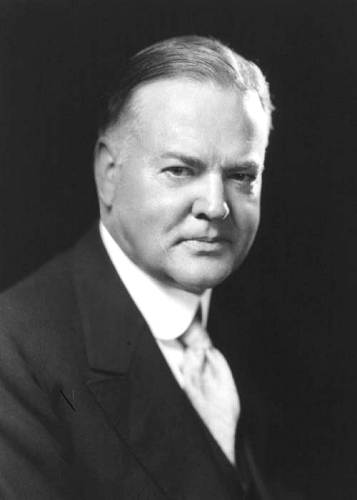
27a Herbert Hoover
In World War I, when Germany declared war on France, many United States citizens were stranded in Europe without money because the banks there would not cash their American checks. Mr. Hoover was asked by the American Consul to help get these people home, and, in six weeks, his committee helped 120,000 Americans return to the States. After the United States entered the war, President Wilson appointed Hoover head of the Food Administration, where he succeeded in cutting consumption of food needed overseas and avoided rationing at home.
Herbert Hoover became the Republican presidential nominee in 1928 and was elected as the thirty first president of the United States, the country’s first Quaker to serve in that office. Charles Curtis (photo 27b), who was part American Indian, born at Topeka, Kansas, was chosen as vice president to serve with President Hoover.
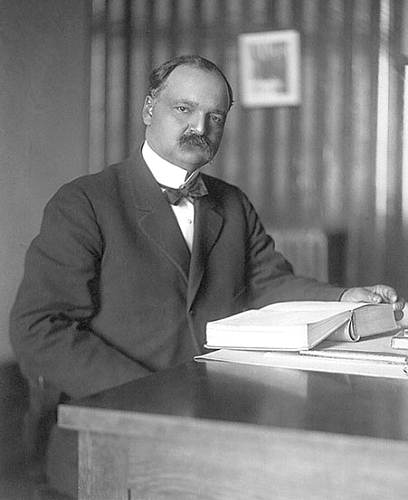
27b Charles Curtis
When elected, Hoover said, “We in America are nearer to the final triumph over poverty than ever before in the history of any land.” Even though his election seemed to insure prosperity, within months the stock market crashed and the nation spiraled downward into depression. Hoover became the scapegoat for the Great Depression, although it was the result of things that had happened before his election.
From 1920 to 1929, the stock market and America were booming. Electric irons, washing machines, vacuum cleaners and refrigerators were commonplace in urban homes throughout the United States.
In the late 1920’s, prices of stocks rose steadily and rapidly until they reached fantastic heights. It was easy to borrow money; and many people, who could not afford to speculate, borrowed money and “played the market.” They bought stocks “on margin” by putting up only ten percent of the stocks’ purchase prices. This meant if a person had one hundred dollars, he could buy stocks worth one thousand dollars. More and more people of moderate means bought stocks, owing more and more money. They believed that the prices of the stocks would keep going up. The banks and brokers had lent so much money that actually they, and not the people, had bought the stocks at the high prices.
William C. Durant (photo 27c), founder of General Motors Corporation, became so concerned in April of 1929 about the stock market’s prospects that he arranged an interview with President Hoover.
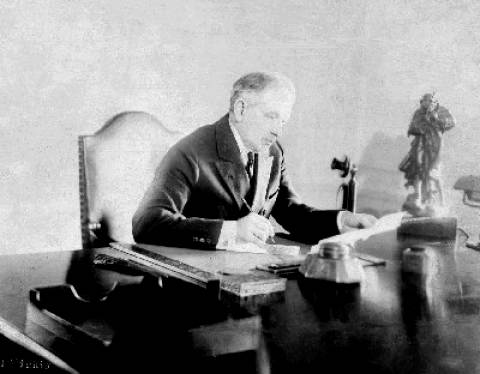
27c William C. Durant
He warned the President that, unless the Federal Reserve System supplied securities credit more freely, a market crash was inevitable.
Early in October 1929, stock prices started to drop rapidly. In late October, the big crash came when sixteen million shares sold in a single day. There were few buyers, so prices kept on dropping and many people lost huge “fortunes” they thought they owned. A financial panic followed…banks and businesses failed and millions of people lost their jobs. Many of those who lost everything committed suicide.
Then came the Great Depression, which lasted throughout the 1930’s. In the mid thirties, the Securities and Exchange Commission was formed and speculation in stocks was better regulated.
The stock market crash hit chiefly the wealthy and the well to do; but it also hurt the blue collar workers who had been laid off by manufacturing industries. In 1933, twenty four percent of the civilian labor force was without work.
Service industries (laundries, barber shops and small retail shops) faired relatively well when they were family owned and operated.
General Motors stayed in the black during the depression, although profits dropped from $248 million in 1929 to $165,000 at their low point in 1932.
Joseph P. Kennedy, a millionaire who began liquidating his stocks in 1928, commented that, “Only a fool holds out for the top dollar.”
In 1931, East Texas was caught up in an oil boom as large oil fields were developed. Small cotton farmers became millionaires overnight. H.L. Hunt, a prosperous lumberman, was about to lose everything. The discovery of oil necessitated the building of wooden derricks, of which he supplied much of the lumber, thus making him a millionaire.
Some good did come as a result of the depression. The public, for obvious reasons, was especially eager to save money, a fact that contributed mightily to the growth of a new type of food store…the supermarket, such as the self service Piggly Wiggly store in Memphis, Tennessee, and the King Kullen supermarket in California, that began opening in such places as abandoned garages.
Movies met the growing public’s demand for entertainment. Businessmen, ashamed to tell their families how little they were needed at the office, used the movies to kill time. Mothers found that, for a dime, they could park their children at the local movie theater for several hours, which was much cheaper than hiring a baby sitter.
During the height of the Prohibition Era in the late twenties and thirties, Al Capone (photo 27d) turned Chicago into a war zone.
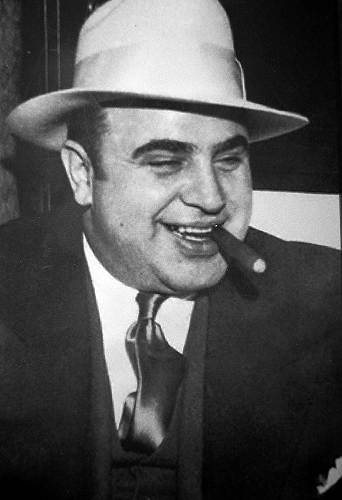
27d Al Capone
He was the leader of a pack of vicious hoodlums and gangsters. His Chicago mob sold illegal liquor to the speakeasies (joints) and private clubs. He was into gambling and racketeering and was the most famous of the mob leaders. In 1931, he was caught for tax evasion and sentenced to eleven years in prison. Later, he became the subject of many movies.
The year 1927 was an interesting one. George Herman, best known as Babe Ruth (photo 27e), hit sixty home runs in the National League.
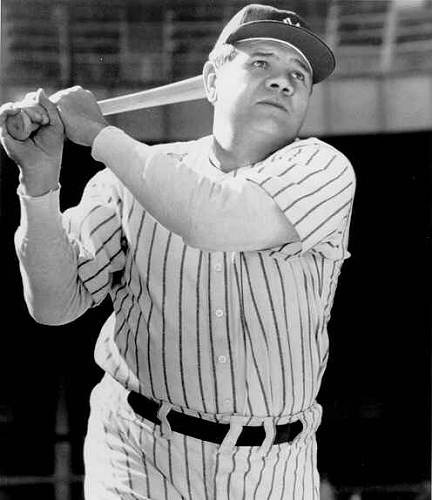
27e Babe Ruth
The famous baseball slugger was known to millions of people; even those who had no interest in baseball knew who Babe Ruth was.
Warner Brothers made a film with sound that year. It featured Al Jolson and was named “The Jazz Singer” (photo 27f).
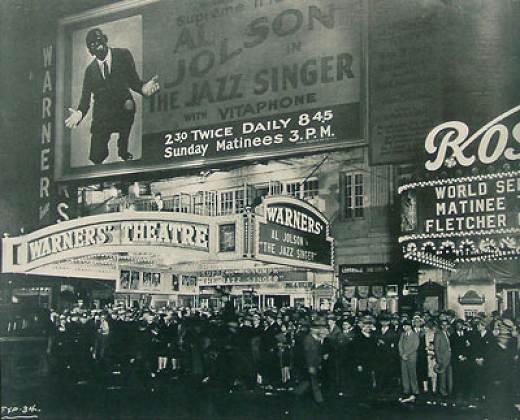
27f "The Jazz Singer"
The Academy of Arts and Science was formed and gave out Oscars. Janet Gaynor (photo 27g), who starred in “Seventh Heaven”, won the Best Actress award. She signed a five year contract for one hundred dollars a week, giving her a twenty five dollar a year raise.
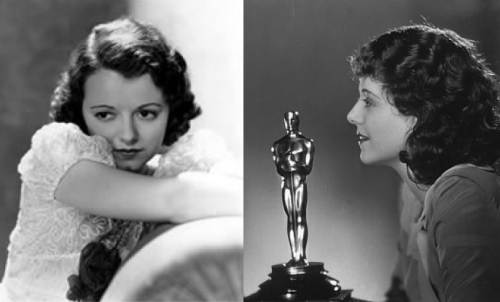
27g Janet Gaynor
Radio broadcasting was seven years old in 1927. Crystal radio sets had given way to eight tube radios at a cost of two hundred seventy five dollars. There were six million sets in the United States. Radio was the link to the ouside world in the twenties and thirties. The recording of “Old Man River,” by Eddie Cantor, was a popular song hit in 1927.
By 1929, some 10,250,000 homes had radio sets. The number rose steadily throughout the depression, exceeding twenty eight million in 1940. The need for diversion during the depression fostered the fast growth of radio. The radio shows of “Amos ‘n’ Andy” and “Fibber McGee and Molly” helped Americans though the 1930’s.
Thanks Nelta for your excellent research and the writing of it so all of us now, quite a few years later, can appreciate more fully the rich history of our county and in particular this week, a wonderful history of Bagnell during the early part of the last century.
I was particularly interested in Nelta’s interpretation and history of the depression era. My father, as many others, was raised on a very poor farm in Wright County, two counties south of Miller County. Because of a severe drought which occurred concurrently for several years during the depression his parents had not only no money but little food. They sent him to Miller County to live with his brother, Ansel Pryor, where he finished high school at Tuscumbia. All my life growing up he never stopped reminding me how difficult those depression days were for everyone for which reason he told me an education was essential to help one have more of a chance to get through that kind of economic crisis. He was the one who helped me get the college education he never had.
Many of the more senior citizens of Miller County have their own unpleasant memories of their experiences during the Great Depression of the 1920’s and 30’s. But as Nelta pointed out toward the end of her essay, the Great Depression stimulated various kinds of innovations and inventions which in the end were the impetus which helped to facilitate the eventual economic recovery in our country.
Once again I want to thank David Statler for his excellent layouts and especially for his research in locating the photographs for the segment by Nelta Pope about the Great Depression.
Quilt Sewing At Miller County Museum
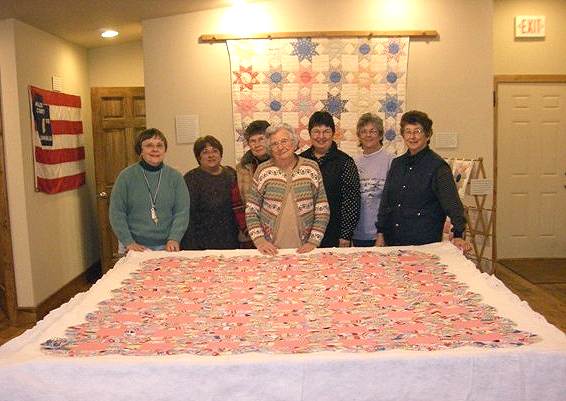
28 Quilting at The Museum
Mondays are workdays at the Miller County Museum. The most recent project is the completion of a quilt made from feed sacks. The quilt was started more than seventy five years ago by Zula Kiplinger of Bagnell, Missouri who sewed together pieces from feed sacks. The pattern is called “Double Wedding Ring.” However the bunting and backing were never added so volunteer Elva Steen (center) is completing the quilt for us. Mrs. Steen has furnished several quilts over the years for the quilt raffle held each fall by the museum. Behind Mrs. Steen left to right are museum director Nancy Thompson and volunteers Diane Berkbigler, Sharon Holder, Judy Pryor, Karen Smith and Doris Wiggins. Mrs. Kiplinger’s husband, Raymond, used to run the ferry at Bagnell and Linn Creek before the Lake of the Ozarks was created. The quilt top was donated by Kathrine McGowin Ryan of Linn Creek, who originally was from Pennytown near Bagnell and was a friend of Mrs. Kiplinger. Lewis Wall of Iberia donated the very old quilt rack, once owned by his great-grandmother, Pelagia Courtois Hill.
That's all for this week.
|

